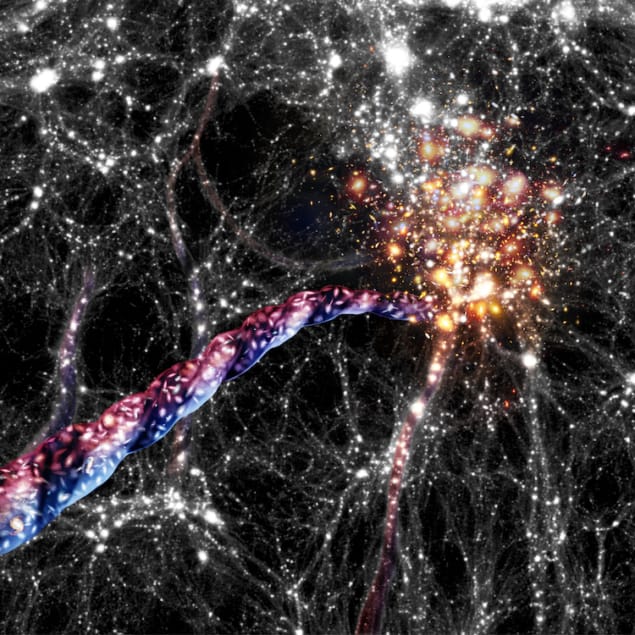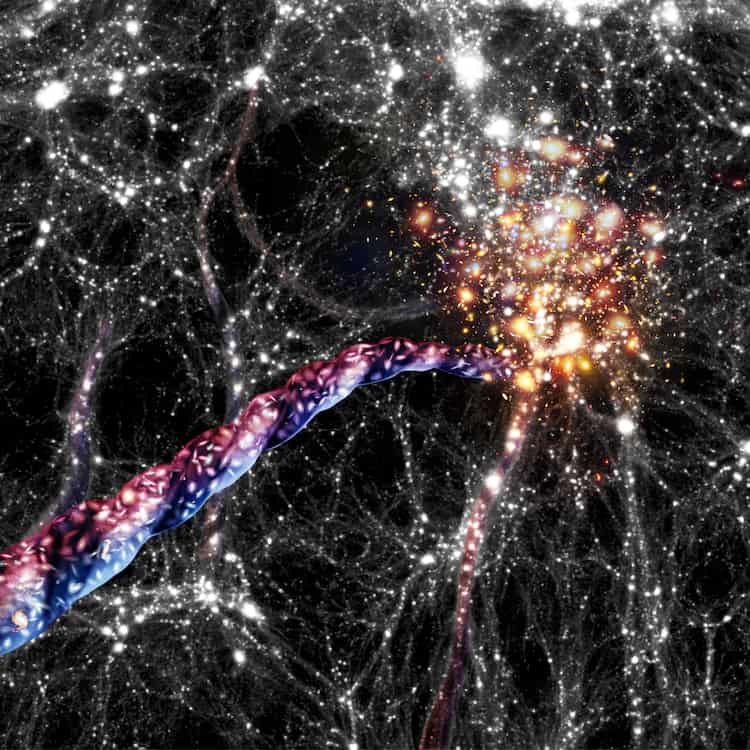
The universe is full of spinning objects. Galaxies, the stars within galaxies, the Earth, the Earth around the Sun, the Moon around the Earth – all rotate around an axis. An international team of astronomers has now added to this list by uncovering evidence that cosmic filaments – tendrils of matter that stretch across hundreds of millions of light years – are also spinning. Rotation on such gigantic scales has never been observed before and the new finding could help explain why galaxies (and indeed every other structure in space) are so prone to rotating.
The origins of cosmic-scale rotation are poorly understood. In the standard model of cosmological structure formation, regions of the early universe with a relatively high matter density grew over time as matter flowed into these denser regions from sparser ones. This type of flow is not, however, associated with rotation (it is curl-free), which means there was no primordial rotation in the early universe. Any rotation we observe today must therefore have been generated as structures formed.
Largest objects known to have angular momentum
One way to understand why this happened is to try to find out where the spinning stops. A team led by Noam Libeskind at the Leibniz Institute for Astrophysics Potsdam (AIP) in Germany set out to do this by investigating whether filaments of galaxies (not just the galaxies themselves) might spin. With lengths in the hundreds of millions of light years and diameters of a few million light years, these filaments are like huge bridges that connect clusters of galaxies to each other, says Peng Wang, a member of the team and lead author of a study published in Nature Astronomy. The filaments also funnel galaxies towards and into the large galactic clusters that sit at their ends.
Previous research had suggested that these clusters might be where spinning ceases, but Libeskind, Wang and colleagues in France, China and Estonia have now turned this idea on its head. “They [galaxies] move on helixes or corkscrew-like orbits, circling around the middle of the filament while travelling along it,” Libeskind explains. “Such a spin has never been seen before on such enormous scales, and the implication is that there must be an as yet unknown physical mechanism responsible for torquing these objects.”
Survey results
The astronomers mapped the motion of galaxies in filaments using data from the Sloan Digital Sky Survey, which recorded the light from hundreds of thousands of galaxies. Since rotation cannot be measured directly on such scales, the astronomers looked for patterns by examining the galaxies’ redshift and blueshift – that is, how quickly the galaxies are moving away from us or towards us.
To do this, they stacked thousands of filaments together and studied the velocity of the galaxies perpendicular to the filaments’ axes. When the majority of galaxies on one side of a filament were redshifted and the majority on the other side were blueshifted, they concluded that the entire filament must be rotating. In some of the filaments they analysed, the velocity of the spin was nearly 100 km/s. From this, the researchers conclude that angular momentum “can be generated on unexpectedly large scale”.

Galaxy rotation study rules out modified gravity, or does it?
Gravitational effect
Another important finding, Libeskind adds, is that filaments at the end of more massive clumps of galaxies appear to rotate faster. While the full reason for this is unclear, he thinks the relationship between filament rotation and the clusters at either end may indicate a gravitational effect. “It could be that the tidal or gravitational field of these clusters is triggering or somehow causing this spin,” he tells Physics World. “One thing we would like to check in the future is if the galaxies inside the filaments are spinning with the same chirality (‘handedness’) as the filament itself. That would point to a coupling of scales on which spin is generated and endowed that is as yet unknown and could hint towards the origin of cosmic spin in general.”
